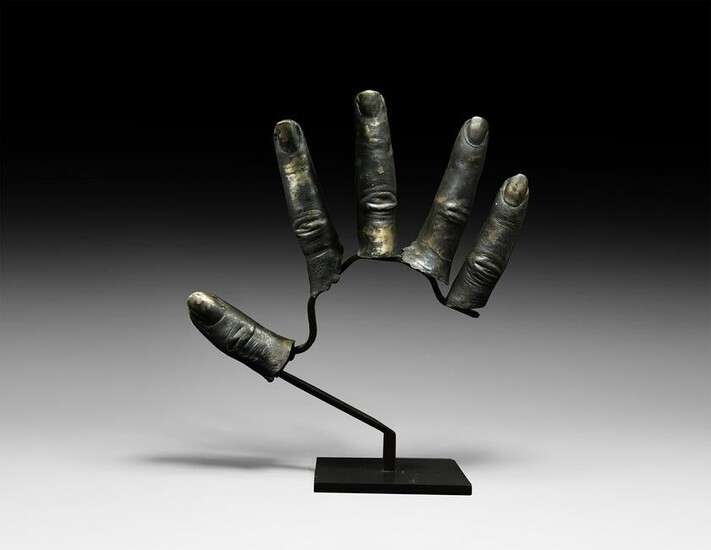Egyptian Silver Finger Stalls
Late Period, 664-332 BC. A full set of sheet-silver finger stalls for the right hand of an important mummy, the knuckles, cuticles and nails well delineated; originally made to protect the mummy's fingers not just from physical injuries during the burial process, but also from magical dangers in the afterlife; mounted on a custom-made display stand. See Lilyquist, C., The Tomb of Three Foreign Wives of Tuthmosis III, New York, 2003, pp. 135-6; Murray, H. & Nuttall, M., Handlist to Howard Carter’s Catalogue of Objects in Tutankamun’s Tomb, Oxford, 1963, p. 9, Objects on the body, Group 256, ll; Reeves, N., The Complete Tutankhamen. London, 1990, p.113; Colazilli, A., Reproducing human limbs. Prosthesis, amulets and votive objects in Ancient Egypt, RES 3 (2012), pp.147-274. 459 grams total, 20cm including stand (8"). From the collection of a Kensington gentleman; previously in the collection of Mrs Petra Schamelman, Breitenbach, Germany; acquired from the collection of Fernand Adda (d.1965), formed in the 1920s; accompanied by an academic report by Dr Alberto Maria Pollastrini; this lot has been checked against the Interpol Database of stolen works of art and is accompanied by AIAD certificate number no.10737-177406. Finger and toe stalls for a mummy are not known before the New Kingdom (18th-20th Dynasties, 1570-1293 BC) and then until the Late Period. They are mainly associated with royalty and those are of gold. Gold was considered to be the flesh of the gods, hence its suitability for use in a royal burial. The mummies of the three princesses of Tuthmosis III (1504-1450 BC) had three groups of finger and toe stalls, 54 in all, in sheet-gold (now in The Metropolitan Museum, New York"). Tutankhamen (1374-1325 BC) had a full set of 20. Finger and toe stalls were found with the mummy of Psousennes I (21st Dynasty, 1039-991) by Pierre Montet amongst the royal burials at Tanis in 1938-9. Finger and toe stalls of silver are extremely rare and were only used by the highest echelons of society and the richest nobility. In ancient Egypt silver was more valuable than gold because it was not found in Egypt, and was at a ratio of 12 to 1, contrary to and in reverse to the rest of the ancient world, until the conquest of Alexander the Great in 332 BC. Thus, in ancient Egypt, this set of silver finger stalls would have been twelve times as valuable as those in gold on Tutankhamun’s right hand. The British Museum possesses a single silver finger stall, BM EA 23564. [A video of this lot can be viewed on the Timeline Auctions website]
Condition Report: Fine condition. Excessively rare.
View it on
Sale price
Estimate
Time, Location
Auction House
Late Period, 664-332 BC. A full set of sheet-silver finger stalls for the right hand of an important mummy, the knuckles, cuticles and nails well delineated; originally made to protect the mummy's fingers not just from physical injuries during the burial process, but also from magical dangers in the afterlife; mounted on a custom-made display stand. See Lilyquist, C., The Tomb of Three Foreign Wives of Tuthmosis III, New York, 2003, pp. 135-6; Murray, H. & Nuttall, M., Handlist to Howard Carter’s Catalogue of Objects in Tutankamun’s Tomb, Oxford, 1963, p. 9, Objects on the body, Group 256, ll; Reeves, N., The Complete Tutankhamen. London, 1990, p.113; Colazilli, A., Reproducing human limbs. Prosthesis, amulets and votive objects in Ancient Egypt, RES 3 (2012), pp.147-274. 459 grams total, 20cm including stand (8"). From the collection of a Kensington gentleman; previously in the collection of Mrs Petra Schamelman, Breitenbach, Germany; acquired from the collection of Fernand Adda (d.1965), formed in the 1920s; accompanied by an academic report by Dr Alberto Maria Pollastrini; this lot has been checked against the Interpol Database of stolen works of art and is accompanied by AIAD certificate number no.10737-177406. Finger and toe stalls for a mummy are not known before the New Kingdom (18th-20th Dynasties, 1570-1293 BC) and then until the Late Period. They are mainly associated with royalty and those are of gold. Gold was considered to be the flesh of the gods, hence its suitability for use in a royal burial. The mummies of the three princesses of Tuthmosis III (1504-1450 BC) had three groups of finger and toe stalls, 54 in all, in sheet-gold (now in The Metropolitan Museum, New York"). Tutankhamen (1374-1325 BC) had a full set of 20. Finger and toe stalls were found with the mummy of Psousennes I (21st Dynasty, 1039-991) by Pierre Montet amongst the royal burials at Tanis in 1938-9. Finger and toe stalls of silver are extremely rare and were only used by the highest echelons of society and the richest nobility. In ancient Egypt silver was more valuable than gold because it was not found in Egypt, and was at a ratio of 12 to 1, contrary to and in reverse to the rest of the ancient world, until the conquest of Alexander the Great in 332 BC. Thus, in ancient Egypt, this set of silver finger stalls would have been twelve times as valuable as those in gold on Tutankhamun’s right hand. The British Museum possesses a single silver finger stall, BM EA 23564. [A video of this lot can be viewed on the Timeline Auctions website]
Condition Report: Fine condition. Excessively rare.



